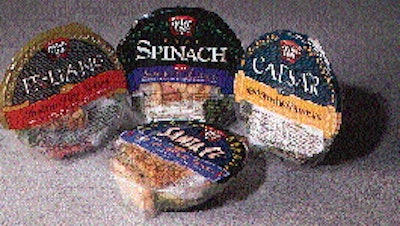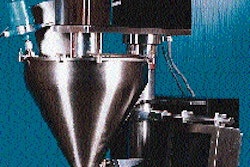The meteoric rise in sales of fresh-cut, prepackaged produce has tapered a bit, and produce marketers now are developing refinements to this growing concept. One of the more interesting is the SaladBowl by SaladTime® line from Tanimura & Antle of Salinas, CA. In April, the firm began testing thermoformed bowls of polyvinyl chloride for single-serve salads in California, Denver, Atlanta, Louisville and St. Louis. "We looked at the single-serve, ready-to-eat segment and realized that none of the available offerings out there were merchandised well," says Leonard Batti, vice president of value-added products at T & A. Not only were these salads not available in salad friendly containers, observes Batti, they were also displayed unimaginatively as well. "So we asked ourselves: How can we duplicate the experience of eating a quality salad in a fine restaurant or in the home," says Batti. The answer: Put the product in a familiar-looking salad bowl. And to make it as convenient as possible, include everything the consumer could possibly need: utensils, napkin, dressing, croutons-even a protein topping, like cheese, salami or smoked bacon bits. The four SaladBowl varieties-like many other new produce packs-come in a package with controlled gas permeability that permits the salad to continue respiring after packaging. Shelf life is two weeks from date of packaging. Controlling permeability The packaging component that controls permeability is the clear lidstock, supplied by James River (Milford, OH). Elsewhere in the fresh-cut produce arena, James River is known for its microperforated material (see PW, March '96, p. 54), an oriented polypropylene with just enough minute perforations to allow produce to respire at the desired rate. But the microperf material is typically used for produce with high respiration rates, above 500 cc/100 sq"/24 hrs. T&A's salads don't need that much permeability. However, because most of the package is highly impermeable PVC, the lidding must be far more permeable than typical produce bag materials. So James River developed a lidstock specifically for the T&A bowl. It's a two-layer coextrusion of polystyrene and ethylene vinyl acetate. The PS brings stiffness and the level of gas permeability desired, while the EVA provides heat sealability. Total thickness, from 21/4 to 21/2 mils, depends on which of the four items is involved. The lidding is peelable, has an antifog feature, and is printed flexographically in eight colors. Special footed bowl The PVC bowl is thermoformed by Winkler Forming (Santa Fe Springs, CA). A specially designed foot not only allows the bowl to display nicely in an upright position, it also houses the prepackaged meat or cheese, keeping them close to the source of refrigeration. Also customized is the corrugated shipper from Weyerhaeuser (Tacoma, WA) that T&A uses to get the SaladBowls safely to market. Developing the shipper, says Batti, was quite a challenge, largely because round containers are inherently inefficient when it comes to maximum use of cube. Further constraining the shipper's design was Batti's desire that it carry a multiple of four packs and that it fit on a 48" x 40" pallet. What emerged looks a lot like an interlocking display case. Made of 200-lb C-flute board, it's an eight-count case with two vertical rows of four bowls separated by a paper divider to prevent chafing of one row against another. Each bowl stands on its foot in the shipper. Die-cut holes in the bottom provide good air flow, and die-cut handles on both long sides make it easier for workers to handle the case. Flexo printing in 3 colors gives the shipper some graphic pop, even though the only time it's seen on the selling floor is when club stores display it in their spacious refrigerated cases. Keeping in mind that the SaladBowl concept is in test, some adjustments may occur as T&A gains more experience and consumer feedback. One change Batti says he'd like to see is for the bowl to be made of polyethylene terephthalate rather than PVC. But early in the project, he says, "We struggled with sealing to PET, so we switched to PVC. The lidding material sealed fine to PET at ambient temperatures. But under cold packing conditions, at 35 degrees Fahrenheit, the film did not seal as aggressively. We wanted between 800 and 900 grams of pull strength, and we couldn't get that high." Thermoformer Winkler and film vendor James River are working with T&A to resolve the sealing issue, and Batti remains optimistic about PET. "We like the clarity and gloss," says Batti. "And we really like the [potential for] recyclability, though we're finding that the difference between a number 3 bug on the bottom of the bowl and a number 1 bug has not turned out to be that big a deal." The "bugs" Batti refers to are the resin code numbers. Rotary sealing system One component of the packaging operation unlikely to change is the rotary sealing system T&A employs. Supplied by Orics Industries (College Point, NY), it runs trays two-up at a top speed of 20 packs/min, though typically T&A runs a bit slower than that. Operators scoop ready-to-pack salad into a bowl, weigh it, add utensils, prepackaged cheese, croutons, salami, or bacon bits, and load the trays into the rotary platform of the sealer. The machine heat seals and trims brightly decorated lidding material from rollstock in register. Net weights of the salads range from 5.4 to 6.3 oz, and the bowls sell for a suggested retail price of $1.99. They're sent to stores on the same refrigerated trucks that carry T&A's other products, both commodity and value-added. The latter, says Batti, have grown in number at an astonishing pace. "A little over three years ago, when our value-added operation was six months old, the one item we had was a three-pound salad mix," he recalls. "Now we have more than 250 SKUs. Along the way we've had to learn an awful lot about managing our inventories. We've always adhered to first-in first-out rotation, but we've gotten more dilligent than ever, making sure that no product stays more than three days in our cooler. It either gets shipped or we send it to the local food bank. "Our retailer customers have had to make some adjustments, too. Some are cross-docking, where product is never even put away in the warehouse, but instead is taken from the truck it arrived in and put on another one for shipment out to a store. Inventory management in general has just become all the more important." Its importance is unlikely to diminish any time soon, as the popularity of value-added fresh-cut produce continues to build.























